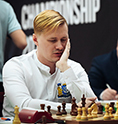13 December 2016
Winter Marathon in Ugra
The Russian Rapid Grand Prix event in Khanty-Mansiysk reviewed by grandmaster Alexey Korotylev.
The world championship match is as unique an event as it is not the only one in the chess calendar. Nevertheless, those other competitions, which partially or completely coincide with the world match schedule and get overshadowed by it, need some help to step out of this “underground.” I will try to give my helping hand to the Russian Rapid Grand Prix event to the best of my abilities.The tournament was a round robin with its favorites and, I will make no secret of it, with its underdogs, much like it was a year ago. However, the former clearly outnumbered the latter as the tournament was joined by new big names to feature a more solid lineup as compared to 2015. These names include Dmitry Jakovenko, Aleksey Dreev and Daniil Dubov. It was Dubov who broke away from the rest of the field following an excellent start to follow it up by confidently retaining the leader's jersey until the very final round. No one seems to be taken by surprise with Jakovenko's second and Alexander Riazantsev's third places (although the victory of any of the two would come as no surprise either).
As opposed to that, it is somewhat weird to see such a class player and rapid chess specialist as Alexey Dreev somewhere in the middle of the standings. An obvious overkill (or, rather, underkill) is 0 out of 28 for Evgeniya Sukhareva and Aleksandra Maltsevskaya (other than their game against each other). Indeed, their male opponents - grandmasters on the whole - are much stronger at the moment, but Maltsevskaya has managed to establish herself not only in the children's but also in the women's chess, so that the objective of scoring a certain amount of points was undoubtedly realistic for her. With the tournament's sporting results otherwise stirring up no special emotions, I suggest switching to the creative content.
Alekseev – Dreev
Caro-Kann Defence
1.e4 c6 2.d4 d5 3.exd5 cxd5 4.Bd3 Nc6 5.c3
Fischer's idea was to meet 5...Nf6 with 6.Bf4. It is this idea that Dreev is about to combat.
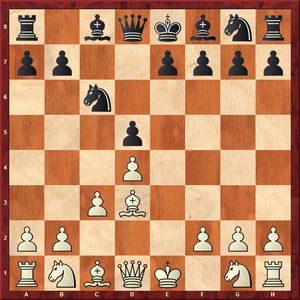
5...Qc7!?
This queen manoeuvre is popular nowadays. Since encountered in Dreev's earlier games, it should come as no news to Evgeny Alekseev. However, the rapid chess has an inherent risk of over- than underpreparation, as was proved by the tie-break of the Carlsen - Karjakin match, but having at your disposal some not overly sophisticated line with a couple of branch lines would help a lot in a rapid encounter.
6.h3!? g6 7.Nf3 Bg7 8.0-0 Nf6
In a blitz game against Artemiev two months earlier Dreev somewhat misplaced his king knight by 8...Nh6. This time Aleksey prefers not going counter to the basic opening principles.
9.Na3
The board edge is more attractive than intimidating for the white knight. This is nothing in the way of obstacles to bring it over into the center.
9...a6 10.Nc2 Bf5 11.Bxf5 gxf5 12.Nce1!
Not just to some random central location, but to the optimal d3-square. White's out-of-the opening prospects look superior.
12…e6 13.Nd3 Ne4 14.Bf4 Qd8 15.Nfe5 Nxe5 16.Nxe5
More precise is 16.dxe5, keeping all trumps and threatening with f2-f3.
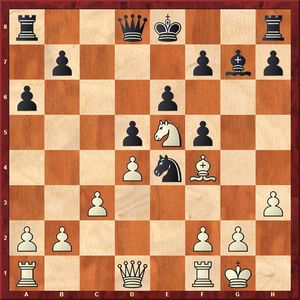
16...Qh4! 17.Nd3 0-0
17...Bh6 seems to be suggestive as Black is OK after the trade of bishops, whereas after 18.Be5 Rg8 White has to be on the lookout for opponent's threats.
18.f3 Nf6 19.Qd2 Nd7 20.Rae1 Rfe8 21.Re2!
The idea behind this seemingly inconspicuous move would be praiseworthy even in a classical format. It is nothing short of splendid when talking about rapid chess.
21...Kh8 22.g3! Qh5
The 22... Qxh3?? 23.Rh2 option was rightly rejected, but Black's difficulties persist. By launching an unexpected kingside pawn storm White capitalizes on the drawbacks of Black's position, manifested in the form of immobile doubled pawns.
23.g4! Qg6 24.Be3 Qf6 25.Rg2 Rg8 26.Nf4 Bh6?! 27.Nxd5!
This should be a seemingly decisive blow. It turns out, however, that any notion of decisiveness in rapid chess should be treated with great care, if not irony.
27...Bxe3+ 28.Nxe3 Qh6 29.d5! Rad8 30.Qd4+ Qf6 31.Qxf6+ Nxf6 32.dxe6 fxe6 33.gxf5 Rge8 34.Ng4?! Nxg4 35.fxg4 exf5 36.Rxf5 Re3
Alekseev's imprecise move 24 afforded Black some active play towards the end of the game. Winning the game now requires pulling yourself together and even calculating something.
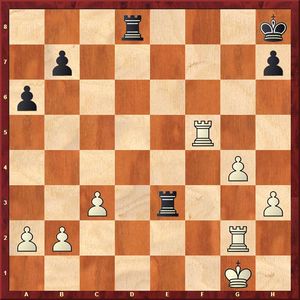
37.Rgf2?
37.Kh2 Rdd3 38.Rh5 is not overly convincing since it is hard to come up with any constructive followup ideas for White. Nevertheless, 37.h4 Rh3 38.h5 should be sufficient because 38...Rd1+ is now met by 39.Rf1.
37...Rg3+?
Black was bound to take the h3-pawn without any delay. However, the rules of the genre bind the opponent to return the favor.
38.Kf1?
Evgeny had no time to calculate that the self-suggestive 38.Kh2 Rdd3 spells troubles for Black after 39.Rf8+! Kg7 40.R2f7+ . For example, 40...Kg6 41.Rf6+ Kg7 (41...Kg5? 42.Rf5+ Kh6 43.Rg8 Rxh3+ 44.Kg2 Rdg3+ 45.Kf2, and Black is able to fend off the checkmate threat of Rf6 only at the cost of his rook) 42.R8f7+ Kg8 43.Rxb7 Rxh3+ 44.Kg2 Rdg3+ 45.Kf2 Rd3 46.Re6, etc.
38...Rxh3
In the game Black grabbed the pawn and achieved an easy draw, although at the moment the winning and drawing chances are approximately level.
Demidov – Riazantsev
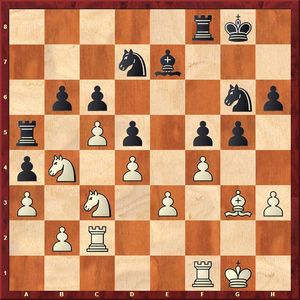
Having opened the game with one of his trademark openings, harmless as a night fly, a young chess player managed to outplay his eminent opponent.
33...Rf6
Black was still holding his position together with 33...bxc5 34.Nxc6 Ra6 35.Nxe7+ Nxe7.
34.Ncxd5
Although it looks effective, even more effective and straightforward is 34.fxg5! hxg5 35.Bc7, inflicting heavy losses to Black.
34...cxd5 35.c6 Bxb4! 36.axb4 Ra7 37.c7 Ne7 38.c8Q+ Nxc8 39.Rxc8+ Kh7 40.fxg5 hxg5
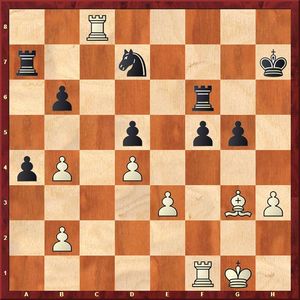
Having eliminated the last and the most active of knights, Alexander Riazantsev has repelled all immediate threats. Nevertheless, an ingenious opponent still finds a way to put Black up against some problems.
41.h4!? gxh4 42.Bxh4 Rf7
Even playing by the rules of the early to mid 19th century (i.e. without a clock), the excessive passivity of such an approach would still go unnoticed with many players. Black should have defended with 42...Rg6+, or better still with 42...Rh6!
43.Kg2!
By providing the f1-rook with access to h1 White threatens to take the endgame offensive that bogged down on the queenside and revive it decisively on the other side of the board. Even though Riazantsev managed to get away with it in the end, it undoubtedly required cooperation from his attacking opponent.
43...a3 44.bxa3 Rxa3 45.Rh1 Kg6?! 46.Rc6+ Kg7 47.Bg5! Nf6
White's idea is best demonstrated by the following cooperative moves by Black: 47...b5 48.Kf3! Ra4 49.Bh6+ Kh7 50.Bf4+ Kg8 51.Rg1+ Kh8 (51...Kf8 52.Bd6+) 52.Rc8+ Kh7 53.Rh1+ Kg7 54.Bh6+ Kf6 55.Rc6+ Ke7 56.Bg5+ Kf8 57.Rg6!, and there is no satisfactory way of stopping the checkmate pending after Rh8.
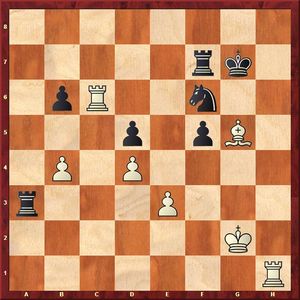
48.Kf3
It would be inappropriate to award question marks to moves played in a rapid game. Let me just note that engineering the already familiar checkmating mechanism with 48.Rh6! would have denied Black any chances of bailing out: 48...Ng8 49.Rcg6+ Kf8 50.Rh8 Rg7 51.Bh6.
48...Ng4 49.Rxb6 Ra2 50.Bh6+ Kg8 51.Rb8+ Kh7 52.Bf4+ Kg7
Here Mikhail's nerves either caved in or he nearly ran out of time as White played 53.Be5+ to surrender his most powerful dark-squared bishop. It soon resulted in a draw, whereas 53.b5 would have retained all winning chances.
Smirnov – Maletin
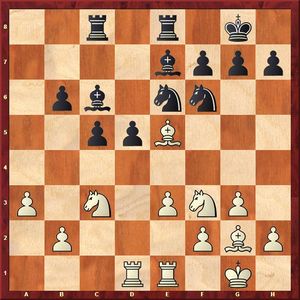
This encounter shines in a way that White fails to convert in yet another sharp ending. It is all the more strange for me who have always considered the degrees of complexity for a defender and attacker changing proportionally once the limited time factor comes into play.
19.h3 Red8 20.g4!?
In the absence of a good plan it is necessary to at least portray having one. Although White threatens nothing, Pavel Maletin prefers getting involved in a kingside brawl nonetheless.
20...h5 21.g5 Ne4 22.h4 f6!? 23.Bh3 Nf8 24.Bxc8 Nxc3!
This is a crucial intermezzo. 24...Rxc8 is decisively met by 25.Nxd5 Bxd5 26.Rxd5 fxe5 27.Rxe5.
25.Bxc3 Rxc8 26.gxf6 gxf6 27.Nd2?!
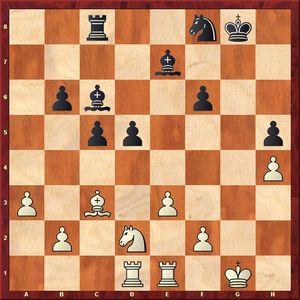
It makes no sense trying to guess if Black blundered or bravely sacrificed the exchange because 27...Ng6 gives him sufficient compensation in this position. Maletin's hesitation resounds fatally for Black.
27...Kf7?! 28.f4! Ng6 29.Kf2 Nxh4?! 30.Rh1 Nf5 31.Rxh5
As if by magic the files have opened up to the much delight of the white rooks. Black is no longer able to hold this game, objectively speaking.
31...Ke6 32.Nf3
In this position, however, White is best keeping control over the light central squares with 32.Rg1 and so on.
32...Nd6 33.Rg1 Ne4+ 34.Ke2 Bb5+ 35.Ke1 Nxc3 36.bxc3 Ra8 37.Rg7 Rxa3 38.f5+?! Kd6 39.Rhh7 Bd8 40.Rh8 Be7 41.Rb8 Ra6?
Black should not have been apprehensive of walking into the pin with 41...Kc7 42.Rf8 Kd6 43.Rff7 and now 43...Bd8 takes White something as complex as 44.Rg8 Be7 45.Rb8 Kc7 46.Rh8 Kd6 47.Nh4 Rxc3 48.Kf2 to reach a decisive advantage. However, 43...Ra7 offers excellent drawing chances.
42.Nh4!
So far White has been up to the challenge as he dispatches his knight to carry out an execution of the inactive e7-bishop.
42...Kc7 43.Rh8 Kd6 44.Ng6 Ra7 45.Rb8 Bc6 46.Rxb6 Ra1+ 47.Kf2 Bd8 48.Rb8 Ba5 49.Ra7
Alas, Smirnov misses a simple 49.Rf8, upon which there would have been nothing better for Black than throwing in the towel.
49...d4!
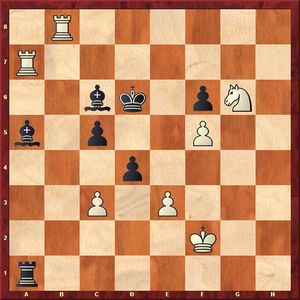
50.Rxa5
A desire to make fun of this decision abandoned me completely when I realized that Black was after creating an agile passer that will be difficult to stop.
The engine allows taking on c3 and stops the black pawn dead in its tracks one step before queening after 50.Rf8 dxc3 51.Rxf6+ Kd5 52.e4+ Kxe4 53.Re7+ Kd4 54.Rd6+ Kc4 55.Ne5+ Kb3 56.Rxc6 c2 57.Rb7+ Bb4 58.Rxc5, which defies calculation in a rapid game, however. Meanwhile, Smirnov, being cognizant of the e1-check threat, prefers keeping a bird in the hand.
50...Rxa5 51.exd4 cxd4 52.cxd4 Rxf5+ 53.Ke3
With the board devoid of material, it makes no sense to persist in arguing further. Draw.
Sukhareva – Riazantsev
Nimzo-Indian Defence
As I mentioned earlier, the male grandmasters give a ruthless treatment to the two representative of the fair sex. To pick up a point the more experienced were sometimes not above resorting to dubious strategy.
1.d4 Nf6 2.c4 e6 3.Nc3 Bb4 4.Qc2
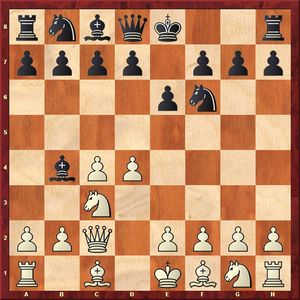
4...b6
This move has always had a dubious reputation until the game Narciso – Vallejo, Spain 2013, upon which it was given a fresh look at by quite a number of renowned players.
5.e4 c5 6.d5?!
A young female player goes astray so early in the game. However, being up against concrete problems over the board, it is far from easy to keep a cool head.
A fundamentally better approach is 6.e5 cxd4 7.a3! (7.exf6 dxc3 8.bxc3 fails to Qxf6) 7...Bxc3+ 8.bxc3 Ng8 9.cxd4 Bb7, although the question of White's edge remains open as a practical side of success has favored Black so far.
6...Qe7 7.Be2 Bxc3+ 8.bxc3 d6 9.h3 0-0 10.Be3?!
In the majority of cases the kingside should precede the queenside development – 10.Nf3 exd5 11.exd5, and should Black employ the game idea 11...b5, his positional weaknesses will be highlighted by 12.0-0!
10...exd5 11.exd5
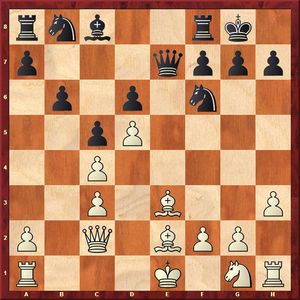
11…b5! 12.Rd1
Now preferable is 12.Nf3 Nbd7 13.0-0 bxc4 14.Bxc4 Nb6 15.Bd3 Nbxd5, at least avoiding a rapid collapse caused by underdevelopment.
12...bxc4 13.Bxc4 Nbd7 14.Bb5 Nb6 15.Bc6? Rb8 16.Qd3
White's last slim chance was in 16.Ne2 Ba6 17.0-0 Qe4 18.Rc1 Qxc2 19.Rxc2 Nfxd5 20.Bxd5 Nxd5 21.Rd1.
16...Bb7!? 17.c4?!
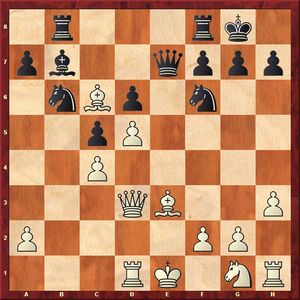
17…Ba6 18.Bb5
The bishop’s infiltrating into the opponent’s camp has in fact turned it into a deserter as White lost control over the vital diagonal a6-f1 with her king still uncastled. Resuming the abandoned duties at this moment is irreparably delayed.
18...Bxb5 19.cxb5 Nbxd5
Black is up material and an overwhelming advantage.
20.Ne2 Rfe8 21.a4 Nb4 22.Qc4 Rbc8 23.Rd2 d5 24.Qh4 d4 White resigns.
Maletin – Rublevsky
Slav Defence
It should be added that the participants were not shying away from theoretical duels either, generally avoided in reduced time control encounters. The below game shows Pavel Maletin giving a big surprise to the Russian national women's team captain.
1.d4 d5 2.c4 c6 3.Nf3 Nf6 4.Nc3 dxc4 5.a4 e6 6.e4 Bb4 7.e5 Nd5 8.Bd2 b5 9.axb5 Bxc3 10.bxc3 cxb5 11.Ng5 Nc6 12.Qh5 Qe7
This line is well-known to the seasoned chess players. Among other things, your attention might be drawn to the game Morozevich - Jakovenko, Loo 2013, in which Alexander opted for 13.h4!?
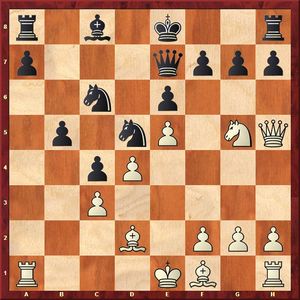
13.Be2
Meanwhile, Pavel had a more natural continuation in store for his formidable opponent.
13...b4 14.0-0 bxc3 15.Bc1 Nxd4 16.Bxc4 h6 17.Ne4
Adhiban-Sibashvili, Nakhichevan 2015, saw 17.Rd1 Nc2 18.Ra5 Ncb4 19.Ne4 0-0 20.Bg5, and Maletin was probably willing to give a try to a similar idea in a slightly different situation.
17...0-0
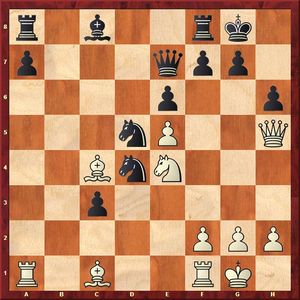
18.Bg5!? f6
The computer insists on a favorable outcome for Black after 18...Qc7 19.Bxh6 g6, which in the over the board rapid game would unlikely elicit an increased amount of trust from an experienced grandmaster, however. Therefore, Sergey goes along with a seemingly more reliable approach.
19.exf6 Qf7 20.Qd1!
Nevertheless, this queen retreat, planned well in advance, puts the opponent up against substantial problems. Black's kingside is vulnerable, after all, while his development issues are still on the agenda.
20...hxg5 21.Qxd4 gxf6 22.Rfe1! Bd7 23.Nd6
One of the worthy alternatives is 23.Ra6!? (threatening Bхd5) 23...Nc7 24.Ra5, and White's initiative is on the rise. As for the game, Black retained his defensive potential.
23...Qh7 24.Bxd5 exd5 25.Qxd5+ Kh8 26.Qc5 c2 27.Rec1 a5 28.Rxc2 Ra6 29.Rcc1 Rc6
This position should be a draw already, although not a plain sailing for Black due to his exposed kingside.
30.Qa3?! Rxc1+ 31.Rxc1 Qe7
It has taken a couple of inaccuracies from White to level the game. However, Pavel does not lose his heart.
32.h4!? gxh4 33.Rc4 Qe1+ 34.Kh2 Qe5+ 35.f4!? Qh5 36.f5
The game ending was a trade, but not a comedy of errors. In fact, there is nothing funny about the nervous tension and frenetic work of mind at times of time trouble.
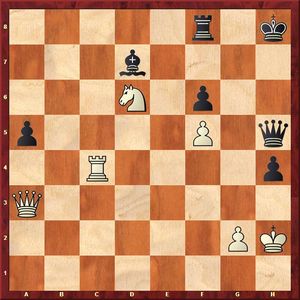
36...Rg8? 37.Qh3?
37.Qc3 was winning, as 37...Rf8 would then run into 38.Qh3.
37...Kg7
If it was a classical game, Rublevsky would have discovered 37...Bc6! with at least equality because 38.Rxc6 is met by 38...Rg3.
38.Rc7
38.Qe3! is very strong.
38...Kh8!
To Sergey's credit he caught sight of the idea of nailing the white queen to the wall. However, the opponent is on the alert as well.
39.Qc3
Anything but 39.Rxd7? Rg3!
39...h3
It is still Black to be the last one to blunder. This is not just bad luck because White was creating threats during the entire game and a vigilant defence is known to drain a lot of energy.
39...Rxg2+! 40.Kxg2 Qg4+ 41.Kf2 Qf4+ would result in a balanced position.
40.Qxf6+ Rg7 41.g4! Qxg4 42.Nf7+ Kh7 43.Qh6+ Kg8 44.Qh8+ Kxf7 45.Rxd7+ Kf6 46.Qf8+ Black resigns.
Smirnov – Volkov
Slav Defence
This game got into this review because of the interesting opening dispute.
1.d4 d5 2.c4 c6 3.Nf3 Nf6 4.Nc3 a6 5.Qc2 b5
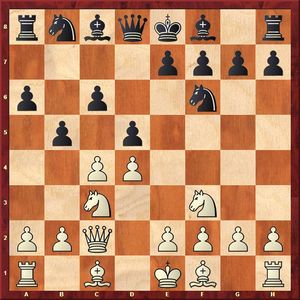
6.e4!?
Even if anyone is amazed by this move, it should by no means be Sergey Volkov. This setup has already been seen in his games.
6...dxc4
This year Sergey successfully employed 6...b4 against Sarana and Hillarp Persson. The alternative continuation yielded Sergey no fruits in this game.
It should be added that 6...bxc4 is met by 7.e5 with compensation.
7.b3 Qa5 8.Bd2 b4
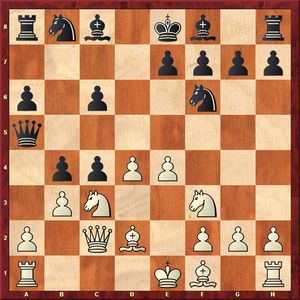
9.bxc4!?
Smirnov’s novelty pays off nicely in this duel. Nevertheless, I am unconvinced that Pavel will ever repeat his choice in a classical game.
9...e5?
For better or worse Black should have accepted the sizable gift offered by his opponent and decided in which direction to direct his knight after 9...bxc3 10.Bxc3 Qc7 11.e5. It feels like White's compensation is enough for equality at best.
10.Na4 exd4
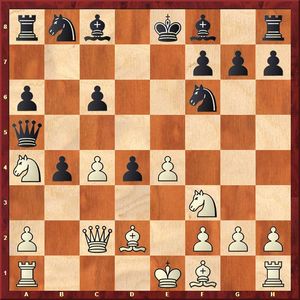
11.c5!
All of a sudden, White's position has become substantially advantageous. After having wasted quite a number of tempi for his queen and pawn moves, White’s army has become too well coordinated for his opponent to cherish any hopes to be pardoned.
11...Nbd7 12.Rc1 Qc7 13.Bxb4 Be7 14.Nxd4 Rb8 15.Bd2 0-0 16.Be2 Re8 17.0-0 Bf8 18.f3
A healthy extra central pawn, coupled with a dominant position of his pieces, gives White ample grounds to count for victory. Pavel went on to convert his edge.
Rublevsky – Dubov
Sicilian Defense
The tournament progress of the future winner Daniil Dubov was very confident. He started with five victories to break away from the rest of the field. Towards the end of the event he scored a crucial victory over one of the most formidable opponents.
1.e4 c5 2.Nf3 d6 3.d4 cxd4 4.Nxd4 Nf6 5.Nc3 Nc6 6.Bc4 e6 7.Be3 a6 8.Bb3 Be7 9.f4 Qc7 10.0-0 Na5
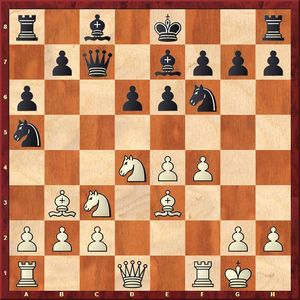
11.g4
Even though this move might be specifically tailored for reduced time control games, it does not strike you as self-suggestive at all. White exposes his king at the moment when Black's king position is not defined yet.
11...h5!?
However, it is not as easy as that: weak is 11...b5 12.g5 Nd7 13.Bxe6, while after 11...Nxb3 12.axb3 the a-file opening puts annoying pressure on Black. Therefore, Dubov decides to grab the bull by the horns.
12.g5 Ng4 13.Bc1!
The positional evaluation largely depends on whether Black has a tough follow-up to his previous idea exactly in this position. My brief analysis convinces me that there is nothing tougher than 13...Qc5 14.Kg2, and White is OK. We need to wait and see how this line shapes itself in future games.
13...b5 14.h3 b4 15.Na4 Bb7 16.hxg4 Nxb3 17.cxb3 hxg4
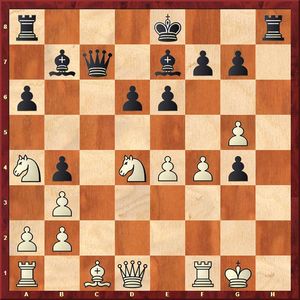
18.Qe2
Despite all the attractiveness of Black's sacrifice it is unsound on the one hand. On the other hand, the practical chances provided by it proved sufficient to retain the top line in the final standings.
18...Rh3 19.Bd2 Kd7 20.Rac1 Qa5 21.Kg2 Rah8 22.Rh1 f5 23.gxf6?
This is a bad blunder as it allows the black queen swinging over to the kingside to join the party of white king's uninvited guests.
The game result would have been different after 23.Rxh3 Bxe4+ 24.Kf2 gxh3 ( 24...Rxh3 fais to 25.Qc4) 25.Qc4.
23...Qh5!
It seems so simple at first glance... However, this simplicity is backed up by years of hard work, coupled with the capability of withstanding high pressures over the board.
24.Qc4 Rh2+ 25.Rxh2 Qxh2+ 26.Kf1 Qh1+ 27.Ke2 Rh2+ checkmating the white king.
Riazantsev – Smirnov
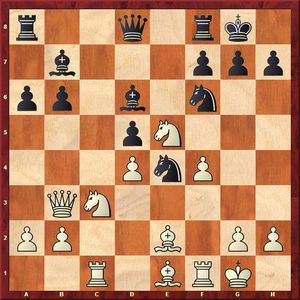
Material advantage would sometimes not lend itself to conversion even under more favorable circumstances, let alone under the barrage of shells exploding everywhere around your king's shelter.
16.Bh4?? Nd2 17.Qc2 Nxf1 18.Rxf1 Be7, and the game ended in... a draw! In terms of point scoring Pavel had perhaps better sacrifice his own piece than grab other player's exchange (see also the game against Maletin).
Lysyj – Demidov
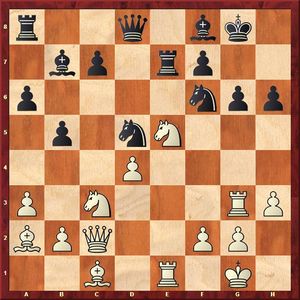
We wrap up the review by a devastating attack, expertly carried out by Igor Lysyj.
23.Rd1
The engine urges this rook to f3 and after 23.Ree3!? Kh8 24.Ref3 Black's king is in bad shape.
23...Qe8 24.Rf3 Bg7 25.Nxg6!
Although one might call this blow elementary and obvious, the previous games’ experience suggests that there is nothing particularly simple about rapid chess.
25...Re1+
In the case of 25...fxg6 26.Rxf6 Bxf6 27.Nxd5 Bxd5 28.Bxd5+ Kh7 29.Bxa8 Qxa8 White should convert his extra pawn as opponent has no shortage of weaknesses.
26.Rxe1 Qxe1+ 27.Kh2 Re8
Now 27...fxg6 28.Rxf6 Bxf6 29.Qxg6+ leads to a quick catastrophe, while 27...Nxc3 can at least be met by 28.Qxc3 Qxc3 29.Rxc3, and Black is doomed.
28.Ne5
Even more convincing is 28.Nh4 to post the knight to the attractive f5-square.
28...c5?! 29.Nxd5 Nxd5 30.Nxf7 Re2 31.Nxh6+!
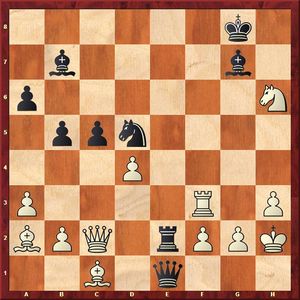
31...Kh8
With no defensive units around, the black king cannot stand the sustained humiliation from the enemy troops that landed on his part of the board.
32.Nf7+ Kg8 33.Nh6+ Kh8 34.Qg6 Rxf2 35.Nf7+ Kg8 36.Nh6+ Kh8 37.Nf7+ Kg8 38.Bh6 and Black resigned as he cannot avoid getting checkmated.
It pleases you, after all, that the modern chess gives players an opportunity to challenge each other in various time formats! Different genres of chess allow attracting more fans and showing one's worth for players with different capabilities in chess. It remains us to wish that the established tradition of the Russian Rapid Grand Prix event blossoms through many years and winters to come (this is a winter tournament, after all)!






















